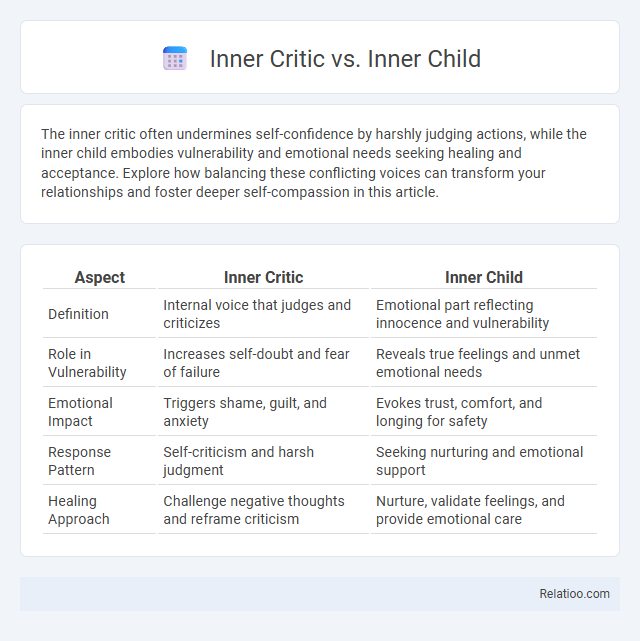The inner critic often undermines self-confidence by harshly judging actions, while the inner child embodies vulnerability and emotional needs seeking healing and acceptance. Explore how balancing these conflicting voices can transform your relationships and foster deeper self-compassion in this article.
Table of Comparison
| Aspect | Inner Critic | Inner Child |
|---|---|---|
| Definition | Internal voice that judges and criticizes | Emotional part reflecting innocence and vulnerability |
| Role in Vulnerability | Increases self-doubt and fear of failure | Reveals true feelings and unmet emotional needs |
| Emotional Impact | Triggers shame, guilt, and anxiety | Evokes trust, comfort, and longing for safety |
| Response Pattern | Self-criticism and harsh judgment | Seeking nurturing and emotional support |
| Healing Approach | Challenge negative thoughts and reframe criticism | Nurture, validate feelings, and provide emotional care |
Understanding the Inner Critic: Origins and Impact
Your Inner Critic stems from early experiences and internalized messages, influencing self-esteem and decision-making by generating negative self-talk and doubt. Understanding its origins in childhood trauma or societal expectations reveals how it undermines confidence and perpetuates fear of failure. Healing the Inner Critic involves recognizing its patterns to reclaim self-compassion and empower personal growth.
Who Is the Inner Child? Defining Its Role
The inner child represents your authentic, vulnerable self, holding memories, emotions, and creativity from early life experiences that shape your emotional responses today. Unlike the inner critic, which judges and criticizes your actions to protect you from harm, the inner child seeks love, safety, and acceptance, often expressing unmet needs or fears. Understanding your inner child helps you heal past wounds, nurturing self-compassion and emotional growth by addressing feelings the inner critic may suppress.
Inner Critic vs Inner Child: Key Differences
The Inner Critic represents a harsh, judgmental voice that focuses on self-criticism and perceived failures, while the Inner Child embodies vulnerability, innocence, and unmet emotional needs from childhood. Key differences lie in their functions: the Inner Critic aims to protect through control and caution, often perpetuating negative self-talk, whereas the Inner Child requires nurturing and compassion to heal past wounds. Understanding these distinctions helps individuals address internal conflicts by balancing self-compassion with constructive self-awareness.
How the Inner Critic Shapes Self-Perception
The Inner Critic shapes self-perception by constantly evaluating and often undermining self-worth, leading to negative thought patterns and diminished confidence. Unlike the nurturing Inner Child, which holds emotional innocence and creativity, the Inner Critic imposes rigid judgments and perfectionist standards that distort authentic self-view. This internal dialogue significantly impacts mental health, influencing behaviors and emotional responses by reinforcing self-doubt and limiting personal growth.
The Inner Child’s Influence on Emotions and Behavior
The Inner Child significantly influences emotions and behavior by embodying unmet needs and early experiences that shape emotional responses and self-perception. Unlike the Inner Critic, which generates self-judgment and doubt, the Inner Child reflects vulnerability, creativity, and authentic emotional expression. Understanding and healing the Inner Child can lead to emotional resilience and healthier behavioral patterns.
Recognizing the Voice of the Inner Critic
Recognizing the voice of the inner critic involves identifying its persistent, judgmental tone that undermines confidence and fuels self-doubt, distinct from the nurturing voice of the inner child that seeks comfort and healing. The inner critic operates through negative self-talk and harsh self-evaluation, often triggered by past experiences or fear of failure. Differentiating these internal voices enables targeted emotional awareness and empowers individuals to challenge critical thoughts while embracing compassionate self-care.
Healing Your Inner Child: Steps to Reconnection
Healing your inner child involves recognizing and soothing the emotional wounds stored from childhood experiences. This process contrasts with managing the inner critic, which often sabotages self-esteem through negative self-talk. Reconnection techniques include mindfulness practices, affirmations, and guided visualizations to nurture self-compassion and foster emotional resilience.
Balancing the Inner Critic and Inner Child for Growth
Balancing the inner critic and inner child is essential for personal growth, as the inner critic represents your self-judgment and desire for improvement, while the inner child embodies your creativity and emotional vulnerability. You can foster emotional resilience by acknowledging your inner child's needs for compassion and play alongside the inner critic's push for accountability and progress. Integrating both aspects leads to a harmonious mindset that supports self-awareness, healing, and sustainable development.
Techniques to Quiet the Inner Critic
Techniques to quiet the inner critic involve mindfulness practices, self-compassion exercises, and cognitive restructuring to challenge negative self-talk. By acknowledging your inner child's voice with empathy, you create a nurturing space that diminishes the power of the inner critic. Using journaling or guided meditations helps reframe harsh judgments, allowing your inner critic to soften and your inner child to heal.
Embracing Self-Compassion: Nurturing the Inner Child
Embracing self-compassion allows you to nurture the inner child by soothing emotional wounds and fostering unconditional self-love. The inner critic often undermines this process by generating harsh self-judgments, but recognizing its voice helps diminish its power. Healing comes from balancing these inner dialogues, promoting emotional resilience and psychological well-being.

Infographic: Inner critic vs Inner child
 relatioo.com
relatioo.com